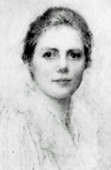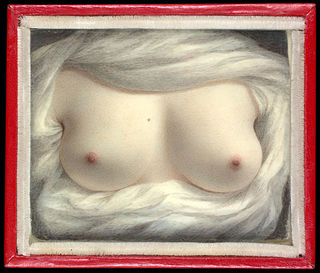
A portrait miniature is a miniature portrait painting, usually executed in gouache, watercolor, or enamel. Portrait miniatures developed out of the techniques of the miniatures in illuminated manuscripts, and were popular among 16th-century elites, mainly in England and France, and spread across the rest of Europe from the middle of the 18th century, remaining highly popular until the development of daguerreotypes and photography in the mid-19th century. They were usually intimate gifts given within the family, or by hopeful males in courtship, but some rulers, such as James I of England, gave large numbers as diplomatic or political gifts. They were especially likely to be painted when a family member was going to be absent for significant periods, whether a husband or son going to war or emigrating, or a daughter getting married.
Henrietta de Beaulieu Dering Johnston was a pastelist of uncertain origin active in the English colonies in North America from approximately 1708 until her death. She is both the earliest recorded female artist and the first known pastelist working in the English colonies, and is the first portraitist known to have worked in what would become the southern United States.

Ellen Wallace Sharples was an English painter specialized in portraits in pastel and in watercolor miniatures on ivory. She exhibited five miniatures at the Royal Academy in 1807, and founded the Bristol Fine Arts Academy in 1844 with a substantial gift.

The Gibbes Museum of Art, formerly known as the Gibbes Art Gallery, is an art museum in Charleston, South Carolina. Established as the Carolina Art Association in 1858, the museum moved into a new Beaux Arts building at 135 Meeting Street, in the Charleston Historic District, in 1905. The Gibbes houses a premier collection of over 10,000 works of fine art, principally American works, many with a connection to Charleston or the South.

Eulabee Dix Becker was an American artist, who favoured the medium of watercolours on ivory to paint portrait miniatures. During the early 20th century, when the medium was at the height of fashion, she painted many prominent figures, including European nobility and famous actresses of the day.
Jeremiah Theus was a Swiss-born American painter, primarily of portraits. He was active mainly around Charleston, South Carolina, in which city he remained almost without competition for the bulk of his career.

Richard Crosse (1742–1810) was a leading English painter of portrait miniatures. He was a contemporary of John Smart, George Engleheart, Richard Cosway and William Wood.

Gervase Spencer (c.1715–1763), was an English miniaturist.

Elizabeth Goodridge was an American painter who specialized in miniatures. She was the younger sister of Sarah Goodridge, also an American miniaturist.

Lucia Fairchild Fuller was an American painter and member of the New Hampshire Cornish Art Colony. She was inspired to pursue art by John Singer Sargent. Fuller created a mural entitled TheWomen of Plymouth for the Woman's Building at the World's Columbian Exposition in Chicago in 1893. Best known for her portrait miniatures, she was a founding member and treasurer of the American Society of Miniature Painters.

Beauty Revealed is an 1828 self-portrait by the American artist Sarah Goodridge, a watercolor portrait miniature on a piece of ivory. Depicting only the artist's bared breasts surrounded by white cloth, the 6.7-by-8-centimeter painting, originally backed with paper, is now in a modern frame. Goodridge, aged forty when she completed the miniature, depicts breasts that appear imbued with a "balance, paleness, and buoyancy" by the harmony of light, color, and balance. The surrounding cloth draws the viewer to focus on them, leading to the body being "erased".

AnnHall (1792–1863) was an American painter and miniaturist.
Mary Harvey Tannahill was an American painter, printmaker, embroiderer and batik maker. She studied in the United States and Europe and spent 30 summers in Provincetown, Massachusetts, with the artist colony there. She was instructed by Blanche Lazzell there and assumed the style of the Provincetown Printers. She exhibited her works through a number of artist organizations. A native of North Carolina, she spent much of her career based in New York.
Glenora Richards was an American miniature painter and designer of postage stamps. The collector Lewis Rabbage called her the "greatest miniature painter of her time, and perhaps ever."

Laura Coombs Hills (1859–1952) was an American artist and illustrator who specialized in watercolor and pastel still life paintings, especially of flowers, and miniature portrait paintings on ivory. She became the first miniature painter elected to the Society of American Artists, and was a founder of the American Society of Miniature Painters. She also worked as a designer and illustrated children's books for authors such as Kate Douglas Wiggin and Anna M. Pratt.

Marie Thérèse de Noireterre (1760-1823) was a French miniaturist.
Sara Peters Grozelier (1821–1907) was an American painter of portrait miniatures. Her name is sometimes given as Sarah.
Hetty Benbridge was an American painter of miniature portraits.
Mary Way was an American painter, known for her portrait miniatures. She, along with her sister Elizabeth Way Champlain, was among the first women to work as a professional artist in the United States.

Jean Antoine Laurent was a French miniaturist and painter.













